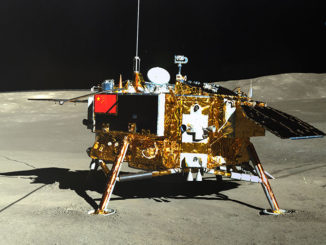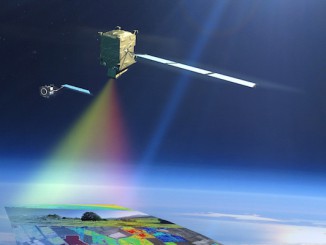In the final months of Europe’s LISA Pathfinder mission, scientists have found an unexpected use for the trailblazing testbed for a future gravitational wave observatory by tracking the tiny dings made by microscopic particles that strike the spacecraft in deep space, exploiting the impacts to learn about the population of dust grains cast off by comets and asteroids across the solar system.
Launched in December 2015 aboard a European Vega rocket, LISA Pathfinder spent more than a year in orbit around the L1 Lagrange point, a gravitationally-stable location nearly a million miles (1.5 million kilometers) from Earth in the direction of the sun.
The $630 million mission’s primary purpose was to test the major advancements required in laser ranging, metrology and other fields to make a space-based gravitational wave observatory possible.
Developed by the European Space Agency with assistance from NASA, LISA Pathfinder contains two identical solid gold-platinum cubes, each about the size of a golf ball, suspended inside separate vacuum enclosures. The spacecraft’s computer receives data from accelerometers, which measure forces and movements acting on the platform, and issues commands to two sets of micro-thrusters to continuously correct its orientation, keeping the two test cubes in suspension inside their cages.
The remarkable precision required for such maneuvering, called drag-free flight, means LISA Pathfinder essentially flies around the test cubes buried inside the spacecraft.
Astronomers can measure gravitational waves by tracking the distance between two masses that are cocooned from other influences, such as solar light pressure, debris impacts and the gravitational pull from the planets.
Scientists are now using LISA Pathfinder, which ESA estimates is 10,000 times more stable than any satellite flown on a previous science mission, to catalog the impacts of tiny grains of dust shed by comets and asteroids transiting the inner solar system.
NASA says the study will help scientists better understand the physics of planet formation, and aid engineers designing spacecraft, helping future missions carrying astronauts better withstand collisions of minuscule dust particles in deep space.
Grains that hit a spacecraft at high speed, sometimes greater than 22,000 mph (36,000 kilometers per hour), can cause major damage.
“We’ve shown we have a novel technique and that it works,” said Ira Thorpe, a U.S. scientist at NASA’s Goddard Space Flight Center in Maryland who works on the European-led mission. “The next step is to carefully apply this technique to our whole data set and interpret the results.”
When something strikes the LISA Pathfinder spacecraft, the micro-thrusters swing into action to maintain position and prevent the probe from spinning, keeping its twin test masses in free fall.

At maximum power, the European-developed cold gas nitrogen thrusters produce the energy equivalent to around four mosquitos landing on the probe. A set of “electrospray” jets made by the Massachusetts-based company Busek and funded by NASA were also demonstrated in space for the first time aboard LISA Pathfinder, proving they could keep the craft pointed with an accuracy equal to the diameter of a DNA helix.
“Every time microscopic dust strikes LISA Pathfinder, its thrusters null out the small amount of momentum transferred to the spacecraft,” said Diego Janches, a Goddard co-investigator. “We can turn that around and use the thruster firings to learn more about the impacting particles. One team’s noise becomes another team’s data.”
Scientists hope the LISA Pathfinder data will yield insights into the interplanetary dust environment, similar to the way NASA’s Long Duration Exposure Facility, a satellite launched by a space shuttle in 1984 and retrieved by a different shuttle in 1990, helped researchers understand the micrometeoroid and debris several hundred miles above Earth.
Microscopic dust grains stream off comets and asteroids as they orbit the sun, producing clouds moving in different directions at various speeds, according to scientists. The dust population in low Earth orbit, where LDEF flew, likely favors smaller and slower particles.
“Small, slow particles near a planet are most susceptible to the planet’s gravitational pull, which we call gravitational focusing,” Janches said in a NASA press release. “This means the micrometeoroid flux near Earth should be much higher than that experienced by LISA Pathfinder, located about 930,000 miles closer to the sun.”
Scientists adapted a software algorithm to help cull data on the spacecraft’s thruster firings to pinpoint the exact location and force of a dust grain impact, allowing experts to reconstruct its trajectory and try to tie the particle to known asteroids and comets, NASA said.
“We’ve demonstrated the dust experiments with both sets of thrusters, although most of the data we’ve looked at to date has been from the European thrusters,” Thorpe said. “The reason is that much of the time in the U.S. mission phase is taken up by experiments to test the thrusters themselves which introduces (deliberate) disturbances on the spacecraft.”
“This is a very nice collaboration,” said Paul McNamara, the LISA Pathfinder project scientist at ESA. “This is data we use for doing our science measurements, and as an offshoot of that, Ira and his team can tell us about micro-particles hitting the spacecraft.”

LISA Pathfinder recently departed its Lissajous-type orbit around the L1 Lagrange point, using its cold gas nitrogen micro-thrusters to nudge the spacecraft away from L1 and into a heliocentric orbit centered on the sun, according to Thorpe.
“This was accomplished using the cold gas micro-propulsion system, which meant that achieving 1 meter per second (2.2 mph) of delta-v (velocity change) took nearly a week of continuous thrusting! The benefit is that for the rest of the mission, we no longer have to maintain the Lissajous orbit so we get round-the-clock science operations for a few more months,” Thorpe wrote in an email to Spaceflight Now.
Gravitational waves are vibrations in the fabric of spacetime, ripples of cataclysmic events billions of light-years away that can only be detected by finely-tuned instruments on the ground or in space. Movements of massive objects in space, such as supermassive black holes at the centers of galaxies, generate gravitational waves that spread throughout the universe, giving astronomers a new way to probe the cosmos without relying on conventional telescopes sensitive to light waves.
A ground-based array called the Laser Interferometer Gravitational-Wave Observatory, or LIGO, made the first detection of gravitational waves in 2015, finding a signal from the merger of two black holes 1.3 billion light-years away.
The faint waves travel through space at low frequencies, so an observatory needs multiple detectors spread over thousands or millions of miles to feel them.
LISA Pathfinder is smaller than a compact car — too small to detect gravitational waves — but it carries sensors similar to the detectors needed for a future space-based observatory, tentatively named LISA, that will include three spacecraft flying in formation about 3 million miles (5 million kilometers) apart
LISA will extend the precision demonstrated by LISA Pathfinder — within a single spacecraft — over millions of miles.
Within the first day of LISA Pathfinder’s science mission in early 2016, the ground team confirmed the craft’s high-tech suite of detectors, lasers, accelerometers and thrusters met the requirements for the LISA gravitational wave observatory.
Scientists have spent the last year refining the sensitivity of LISA Pathfinder’s instrumentation, exceeding the performance needed by the LISA triplets, which will be capable of detecting gravitational waves at frequencies a hundred to a million times lower than the ground-based LIGO array.
ESA is planning to lead the design, construction and operation of the LISA observatory, which could launch in the early 2030s. The agency’s science program committee is expected to meet in June to formally select a design for the LISA mission.
NASA aims to be a junior partner on the LISA mission, responsible for about 20 percent of the program cost, according to Paul Hertz, director of NASA’s astrophysics division.
“But our 20 percent includes involvement in the mission architecture and systems engineering aspects of the mission, as well as contributions of technology both to the consortium for inclusion in the payload, and to ESA for inclusion in the spacecraft,” Hertz said Monday at a meeting of NASA’s Astrophysics Advisory Committee.
NASA might contribute phasemeters, micro-thrusters, lasers, telescopes or components of the mission’s charge management system, according to Hertz.
The U.S. space agency is funding technology development efforts in several areas, including micro-thrusters and lasers, that could be employed on LISA.
ESA’s operations team is scheduled to switch off LISA Pathfinder around July once its final demonstrations are complete.
Email the author.
Follow Stephen Clark on Twitter: @StephenClark1.



